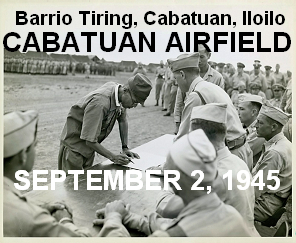
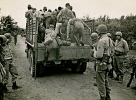

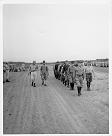


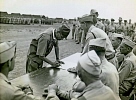
Col. Ryoichi Tozuka signs the surrender instrument
as Col. Raymond G. Stanton looks on.
Cabatuan Airfield
Barrio Tiring, Cabatuan, Iloilo
Panay Island, Philippines, September 2, 1945
|
|
- o -
|
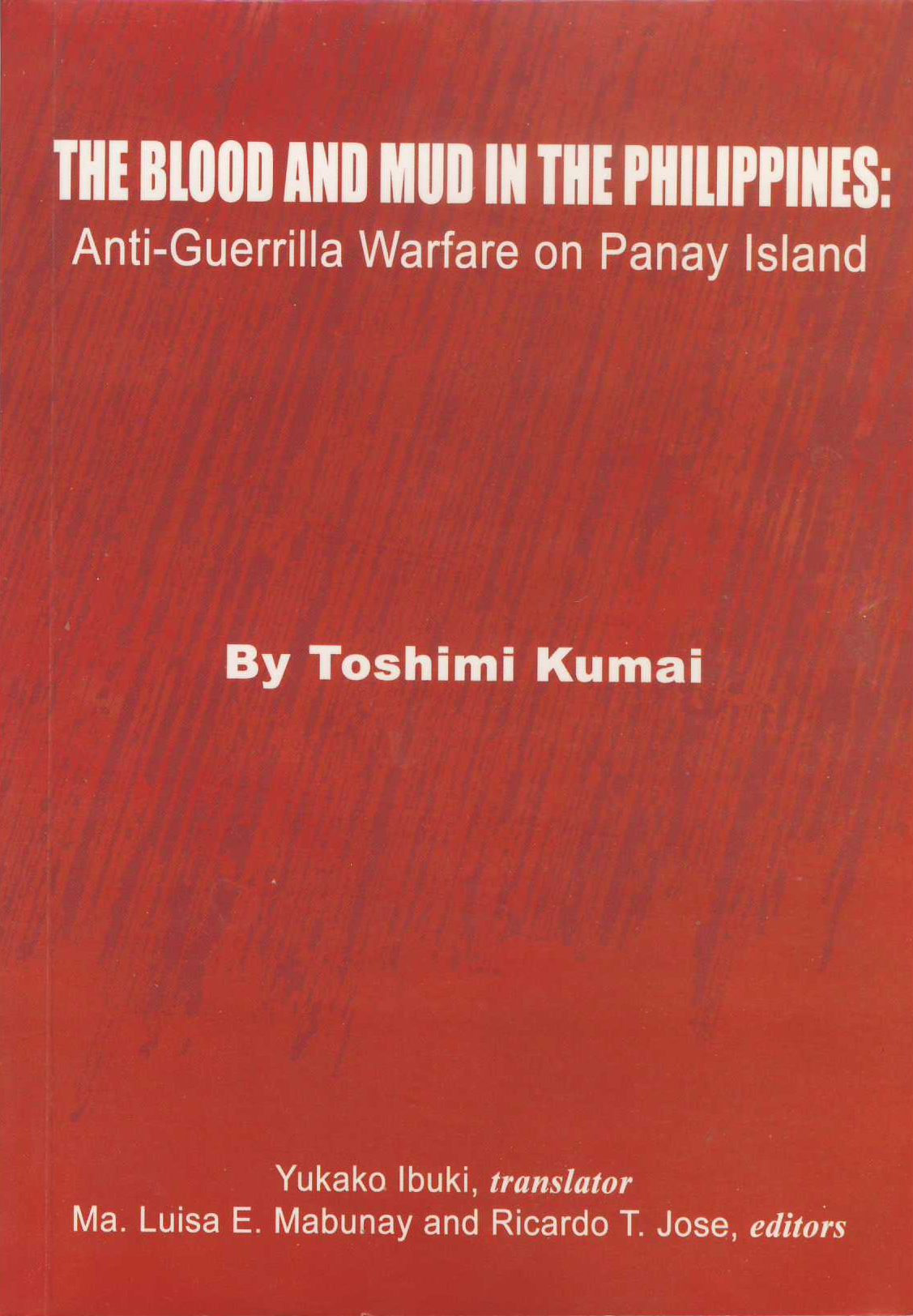
The Blood and Mud in the Philippines
Anti-Guerrilla Warfare on Panay Island
by Toshimi Kumai
Yukako Ibuki, translator
Ma. Luisa E. Mabunay and Ricardo T. Jose, editors
|
|
Chapter 7 – Mortal Combat
7.1 Air raids and the landing of US forces at Leyte
In March 1944, the Imphal Operation (Indian territory invasion operation) started. In addition, by April, the Japanese Army’s 16th Division headquarters advanced from Luzon to the island of Leyte.
Early in June 1944, the Allied Forces in Europe landed at Normandy. On June 19, the Battle of the Marianas was fought. In July 7, the Japanese Army on Saipan Island was annihilated. The shade of defeat had come to color those days. Of course, in Panay we could just guess at the whole war situation from the urgent movements of the Japanese forces around us.
In July 1944, the set-up of the Japanese Army in the Visayas Area was strengthened in preparation for the expected attacks of US forces. On July 26, the 14th Area Army (Homen Gun) established a new unit, the 35th Army, with its headquarters in Cebu City. It was placed under the command of Lieutenant General Munesaku Suzuki, with Yoshiharu Tomochika as the Chief of Staff.
The 37th Independent Mixed Brigade was reorganized into the 102nd Division with its headquarters in Iloilo City. Under this Division, the new 77th and 78th Brigades were organized, respectively commanded by Lieutenant General Kono and Major General Manjome. The commander of the 102nd Division was Lieutenant General Shimpei Fukue, commander of logistics under Lieutenant General Yamashita in the Singapore invasion. Lieutenant Colonel Hidemi Watanabe became the staff officer in charge of Division operations. The promotion to Major of Captain Kengo Watanabe and his assignment as Senior Adjutant officer of the 77th Brigade was through the recommendation of Colonel Hidemi Watanabe.
In May 1945, in a battle with US forces east of the town of Silay on Negros Island, a mortar shell hit and killed Major Kengo Watanabe. He was a leading man of merit in the war of Panay and died a glorious death as a Japanese soldier. Nevertheless, his notoriety as ‘Captain Watanabe’ is still remembered there. Mr. Osamu Yokoi of Oita Prefecture wrote, ‘I attended the burial of Senior Adjutant Watanabe. We dressed him in a new uniform, laid his sword on his chest, and a bottle of his favorite whisky beside him. After cutting his hair and little finger to be sent to his family, we buried him, praying that his soul will sleep in peace. Tears came into my eyes.’
With the reorganization in July 1944, a labor unit (sagyo tal) of 50 men led by 1st Lieutenant Michio Saitô was attached to Lieutenant Colonel Tozuka’s 170th Independent Infantry Battalion. I succeeded Captain Jiro Motoki as Adjutant of the battalion upon his assignment as Junior Adjutant Officer of the Division headquarters.
By the end of July, the Division headquarters was set up at the Iloilo High School. Henceforth, the headquarters of the Tozuka garrison unit moved to Iloilo City Hall. With the establishment of the Division headquarters, various elements – such as communication, artillery, transport, engineer, and so forth – advanced into the city, which then began to see crowds of Japanese soldiers. Nevertheless, the equipment of each unit was extremely poor. For example, the artillery unit only had US 75 mm field guns captured in Bataan, the engineer battalion did not have enough shovels, and the transport battalion had no horses – not even those of low quality – not to speak of any trucks. Soon after, these units would become part of the final battle at Leyte.
After the transfer of Division headquarters, Colonel Satoshi Wada, the Chief of Staff of the 102nd Division, ordered the formulation of the Iloilo City Defense Plan – along with the construction of air raid shelters and the Division defense position at Cordova (in Tigbauan, Iloilo) – in anticipation of the US forces’ attack on Panay. We made several concrete air raid shelters for the Division Commander and general staff as well as for Colonel Ryoichi Tozuka and officers of the unit headquarters.
In the meantime, the guerrillas had been supplied with mortars, rocket launchers, rifles, carbines and so forth, that made their equipment far more superior to that of the Japanese Army. They had become a handsome proper army of the Philippines.
The guerrillas started to attack during the day. Their bullets even reached the quarters of Division Commander Fukue near the Iloilo High School. Daily reports from garrisons at different areas were showing that they were under attack by guerrilla forces with superior firearms. Clearly, the guerrilla resistance was by now operating at full scale. Consequently, Colonel Tozuka ordered the chief of the 3rd Company that was at the Tigbauan garrison to send 2nd Lieutenant Itsusuki’s platoon to Iloilo City to serve as the defense unit for headquarters. Its primary responsibility for now was to protect and defend the city against guerrilla attack.
Announcing that soldiers should become used to battles, staff officer Colonel Hidemi Watanabe ordered any newly-arrived units from Japan (i.e., transport, engineer and others) to defeat the guerrillas. Some of them had fought in combat and expeditions in China. But when they were met by a guerrilla ambush, they were astonished by the overwhelming superiority of enemy firearms that were in no way comparable to those of the bandits in China. Unable to put together any counterattack, all they could do was to lie on the ground and finally ran back after many soldiers among them had been killed.
Each time a new unit arrived, staff officer Watanabe dispatched them on punitive expeditions so that they could gain experience. This caused a large number of casualties, but he gave them no consideration at all. The commander of the unit that suffered most requested for help from the heavy weapons forces of our unit. He led counterattacks against guerrillas in retaliation for the death of his subordinates. Eventually, his group grew to be a capable combat force.
On September 15, US forces landed on the island of Peleliu. It was around this time that the US air attacks began on the Philippines, with Davao receiving daily air bombings. US submarines also begun to be active; they sank and damaged Japanese transport ships, causing a halt in the sea traffic across the Philippine Islands. Continuous bombings took place at Cebu City on September 12 as well as on the northern part of Negros Island on the 13th. Moreover, on the morning of September 14, about 50 to 60 Grumman planes raided Iloilo City.
The enemy planes rained bombs on the Mandurriao airfield and the Iloilo Port. The southern part of the city was bombed as well. The Japanese had no anti-aircraft guns, and no friendly planes flew to challenge the carrier planes before they left.
In time, the city became quiet again; but several Japanese planes were destroyed and several ships were sunk at the harbor. Civilian houses were damaged, and a number of people were killed or injured.
Many residents left the city in terror. I visited the house where Major Castillon’s daughter Thelma and her brothers were, but they had already gone. More and more people kept leaving the city, drastically lessening the numbers of those who remained. One day a young Filipino brought me a letter from Thelma Castillon. In a scribble, she wrote, ‘I’ll never forget the kindness I received from you and the unit commander.’ Colonel Tozuka was glad too, saying, ‘She was a nice girl. I’m very happy to know they are safe.’
After the war, in the petition letter she wrote with her father for my release from Sugamo Prison, she said, ‘Had I not been helped by you, I would not be able to enjoy this happy life I have now.’ With words of thanks, she told me about her reunion with her parents and that after the war, she had graduated from university and was working for the Department of Labor. Her brothers were attending colleges of medicine and dentistry, and high school.
On October 16, to the musical accompaniment of the Warship March, the Imperial General Headquarters announced over the radio that the sea battle off Taiwan was the greatest Japanese victory since the attack on the Pearl Harbor. I felt the release of frustrations caused by US aircraft flying over us, dominating everything with their absolute power. The news commentator went on to say that the US advance to the Philippines had thus suffered a setback. That made us all feel greatly relieved.
Staff officer Hidemi Watanabe ordered the circulation of this news to the Filipino people as well and posted announcements on walls in various parts of the city, although no one was there to read them. Nonetheless, few days later, planes from the US Task Force flew southward from the sea off Taiwan and again attacked various airfields in the Philippines. This threw us into a state of disarray. The Division staff was also confused. As if urged on by the air raids, the guerrillas who had surrounded Iloilo City began to openly attack with mortars. While fighting with the guerrillas everyday, we also had to prepare for the US landing. The routes connecting our garrisons were under guerrilla control and we were just able to hold on to points still under our control.
In the midst of worsening war conditions, around October 7, we received a telegram that said, ‘General Yamashita, the Supreme Commander of the Area Army in the Philippines, takes direct command himself.’ General Tomoyuki Yamashita, the Tiger of Malaya, was the general considered the best commander in the battlefield, and we all felt encouraged. At the same time, we understood the dedication of the Japanese Army to the war in the Philippines.
On October 18, we received a report that the US fleet had bombarded the east coast of Leyte. On the 20th, a report came in: ‘US forces landed on Leyte. The 16th Division is counterattacking.’ We first heard some good news about the battle of Leyte. Then, there was a deafening silence.
|
|